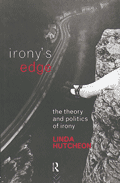
Irony’s Edge: The Theory and Politics of IronyThe often “cutting” edge of irony is always a social and political edge. Arguing that irony isn’t something we have to “get” but rather something that “happens” in the tricky, unpredictable space between expression and understanding, between ironist and interpreter who share a discursive community. Using examples that range from a clever quip in conversation to a contentious museum exhibit, from Madonna to Wagner, from Anselm Kiefer to Shakespeare, this book offers a comprehensive theory of irony’s myriad forms and effects--and its politicized contexts. Building on the vast corpus of work done on irony by others in a range of fields, it examines how and why irony comes about (or doesn’t), with a particular interest in the ethical and ideological consequences of calling a work (in any medium) “ironic”. Table of ContentsIntroduction: Chapter One: Risky Business: The “Transideological” Politics of Irony Chapter Two: Chapter Three: Chapter Four: Chapter Five: Chapter Seven: |